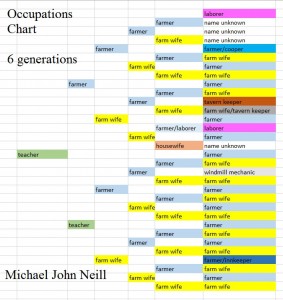 Ancestor Archaeology posted an occupations chart to complement the other colorful charts that have been floating around cyber genealogy land.
Ancestor Archaeology posted an occupations chart to complement the other colorful charts that have been floating around cyber genealogy land.
I knew what mine was going to look like before I even started. With the exception of a third-great-grandmother who ran a tavern for a time in the 1850s, my mother was the first person to have a “non-farm” job. Similarly my male ancestors are all farmers until my ggg-grandparent generation where I have a tavern keeper, windmill mechanic, and part time cooper thrown in the mix. I don’t have any “town dwellers” in my ancestry until my ggg-grandparents’ generation. Even then, it’s the distinct minority and my background is decidedly rural.
I decided not to go back one more generation because I have some occupations that I have not tracked. In my maternal families I have known occupations, many of which translate loosely to “farmer,” but there are different words for farmer in their low-German dialect that translate loosely to:
- farm laborer
- farm owner
- farmer who rents the ground he farms
It is worth remembering that in some languages there may be several words that translate to one broader, more generic, occupation. The variations may imply social status, general economic standing, etc. While it’s a good study, it will have to wait.
I chose to use “farm wife” for those female ancestors whose husbands were farmers as I feel that is a more accurate description. I also did not guess at occupations where I did not have names.
My birthplace chart is more varied than this one.
That’s a good reminder that our ancestors may be homogeneous in some ways and not in others. Any one chart has limitations.

7 Responses
You are right to point out limitations in such charts. Most professional weavers worked at that trade mainly in winter. One of my ancestors was a coachmaker as well as farmer. Not all tradesmen worked full-time in any occupation. Many of our kin were flexible as to what they did to make a living.
While I’m a big fan of charts to organize, I think that one always needs to be aware of the limitations inherent to any organizational structure. Sometimes thinking about the limits gives one an idea for another chart or how to improve it, but not always.
Even “farmer” really isn’t as descriptive as one may think. I’ve got farmers who were tenant farmers, small landowners who barely scraped by, and ones who were more successful. It’s hard to convey those things in chart of this type.
they are a bit of fun at best, who has an ancestor that did the same job all their lives?
Would love to do the chart, but haven’t a clue about Excel.
Bonnie, I don’t know how to do an excel chart but made tables and put headings and filled in underneath. For me they work well and are simple to do. I have different columns for NAME, DATE OF BIRTH, PLACE OF BIRTH,CHRISTENING, MOTHER, FATHER, MARRIAGE, SPOUCE, DEATH DATE, DEATH PLACE, BURIAL. This may work for you too. Good luck!
Learn how to use Excel. It is still the best, simplest, and in many ways, the most powerful tabular data tool out there.
Excel was used to make the chart. All I did was take a screen shot 😉